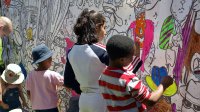Schoolwide Community Service and Volunteering in the Elementary Grades
Opportunities for service learning and volunteering don’t just help the community around the school—students benefit as well.
Your content has been saved!
Go to My Saved Content.Out of all the content we teach as elementary educators, I believe lessons of kindness are some of the most valuable. I have found myself wondering, how can we make the timeless Golden Rule—treat others as you’d like to be treated—really stick?
Students learn new skills each day, such as how to read and write, solve problems, and resolve conflicts. Through the process, they evolve as critical thinkers. But it’s also important to model social and emotional skills and dispositions like compassion, social awareness, and civic responsibility.
At our elementary school, we want every member of our community to embrace their own unique identities and extend empathy toward others, as a bridge across lines of difference. We’re on a journey to teach our students that they don’t have to settle for the status quo, but rather they can be agents of change and make a lasting impact.
Service learning and volunteering can be a powerful, transformative way to help children of all ages understand that they are valuable pieces of a broader community puzzle with the power to give back and improve the world around them. Schools should explore a range of opportunities to ensure that every participant reaps the benefits.
Helping Others Helps Us All
Schools aren’t just helping the surrounding communities when they incorporate service learning and volunteering into their mission.
When connected to specific lesson topics, students develop a deeper connection to what they’re learning in memorable ways that last longer. Children learning about photosynthesis while planting trees and flowers or older students tutoring their younger peers are reciprocal service learning opportunities that can increase self-efficacy while fostering a stronger understanding of the content. But even when volunteering isn’t tethered to a specific academic goal, participants still benefit in more ways than one.
Bottling up all of our schoolwide enthusiasm and directing this collective energy toward strategic acts of kindness for others has been so transformative at our school. Our students propose ideas for how to assist others and have jumped right into service so naturally—even children as young as 3 years old. We’re definitely still a work in progress, but we’re on the right track. It’s so rewarding to see our students develop as problem solvers and leaders.
Mark Your Calendars
A great place to start is by ensuring that your school’s list of key dates reflects community service and volunteering as a priority. Consider adding any of the following service-day ideas or whole-school community events to your schedule.
Beautification day(s) work great in August/September for back-to-school painting and classroom set-up or sprinkled throughout the year. Students can design and paint a mural, organize a litter cleanup, or do other general campus maintenance like gardening and weeding.
International Volunteer Day, December 5, is an annual, internationally celebrated holiday to recognize the work of United Nations volunteers, as well as those who volunteer to help others all around the world. It’s a great opportunity to discuss community service with students, continuing the conversation about ways they might like to get involved.
Martin Luther King, Jr. Service Day (celebrated the third Monday in January) is the only federal holiday designated as a national day of service to encourage all Americans to volunteer to improve their communities. In honor of Martin Luther King, Jr. Day, our school rallied together for what we called our “Be the Change” Community Service Day. Students brought in change from their piggy banks to support one of our local nonprofit organizations. Our generous students not only raised $300 but modeled for themselves, their families, and the community what it means to care and contribute.
Once you start, the ripple effect is contagious. As the year progresses, your school community may continue to design and carry out various projects without any prompting, like ours did. Not only did students raise money to support Ukrainian refugees, but our first graders had a yard sale with their own items, donating the proceeds to a humanitarian organization.
Projects should address the identified need but also be responsive to students’, staff’s, and individual families’ levels of comfort. When gathering large groups of people together, it’s important to specify the health and safety guidance for the event ahead of time—such as expectations for wearing masks, sanitary materials needed like gloves, or health screenings—so that participants are prepared.
Whole-School Community Service Ideas
Young minds have a great many creative ideas to offer, so student voice is critical in this process. By class or grade level, students can identify a problem or a need they would like to address and propose ways to be a part of the solution:
- Host student service clubs for routine action and engagement. For example, students can form a recycling club or “green team.”
- Design mentoring programs that pair members of your community together to help create a culture of belonging and inclusion. Consider peer-to-peer, new staff with veteran staff, or family-to-family mentors.
- Write letters of appreciation to let someone know you care, or consider notes of encouragement for someone who might need a pick-me-up.
- Coordinate a schoolwide march for students to advocate for causes that interest them, such as promoting friendship or bullying prevention.
- Collect and donate items for those in need with coordinated drop-off or pickup (nonperishable goods, toys, books, toiletries, holiday gifts).
